Purple is a color that is often associated with royalty, luxury, and sophistication. So, what better way to add a touch of elegance to your garden this spring than with some beautiful purple flowers? There are numerous varieties of purple flowers, so you’ll be sure to find the perfect ones for your garden. And not only will these flowers look great, but they’ll also make your garden smell incredible! The sweet fragrance of spring flowers is one of the best things about the spring season. So, if you want to add extra beauty and charm to your garden this spring, consider planting some beautiful purple flowers!
Here are some options to consider:
1. Crocus (Crocus sativus)
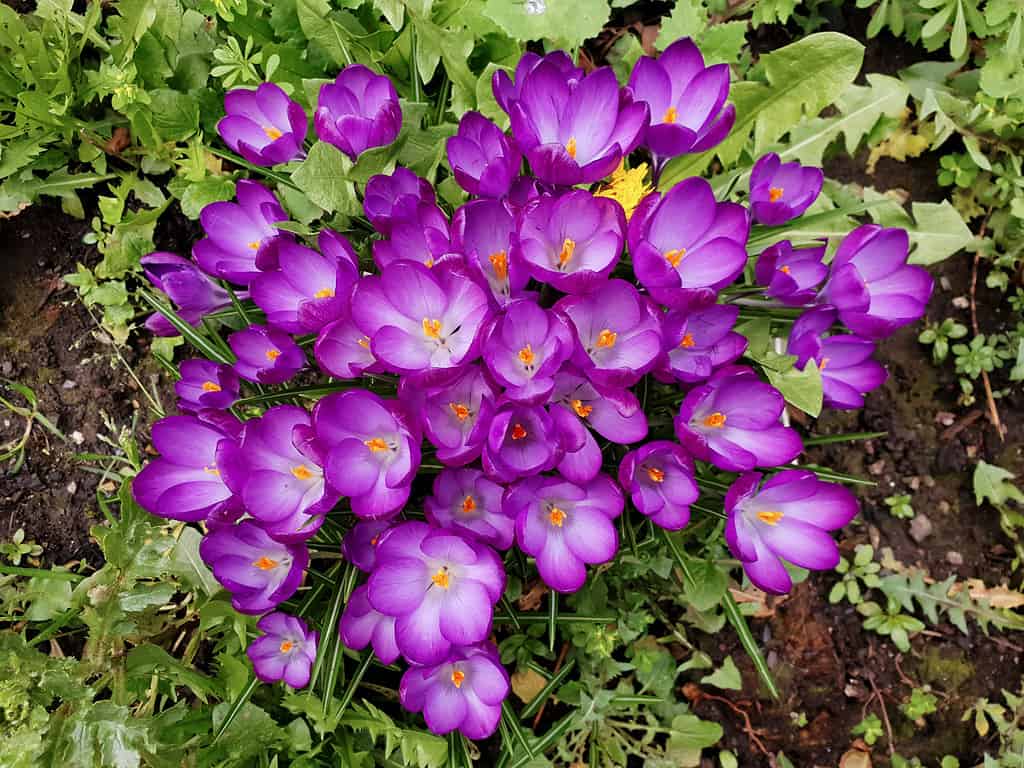
Purple crocuses are often associated with the arrival of springtime, as they are one of the first flowers to bloom after a long winter.
©iStock.com/Wirestock
Crocuses are wonderful flowers that typically bloom in bright purple, white, and yellow shades. They are native to rocky mountainous regions and can thrive in cooler climates, although they require full sun. Crocuses are often associated with the arrival of springtime, as they are one of the first flowers to bloom after a long winter, luring bees out of their winter hibernation.
However, it’s best to be aware that creatures like deer and squirrels may enjoy snacking on crocus plants from time to time, so be sure to plant them in a location these animals can’t easily access.
2. Dwarf Iris George (Iris histroides ‘George’)

The dwarf iris George is native to Europe and Asia but can be grown in most climates.
©Aleksandr Naumenko/Shutterstock.com
The dwarf iris George is a perennial plant that produces jewel-toned purple flowers. These flowers bloom in late winter and early spring, making them a great addition to any garden. The dwarf iris George is native to Europe and Asia but can be grown in most climates. When caring for your dwarf iris, it is essential to plant them in well-drained soil and water them regularly. They also prefer full sun or partial shade, so place them in an area of your garden with plenty of sunlight.
This plant is susceptible to pests such as aphids, thrips, and spider mites. These pests can cause damage to the flowers, buds, and leaves of the iris. So, if you see any of these pests on your plant, it is crucial to remove them immediately. There are a few different ways that you can do this, including picking them off by hand or using a pesticide to kill them.
3. Grape Hyacinth (Muscari)
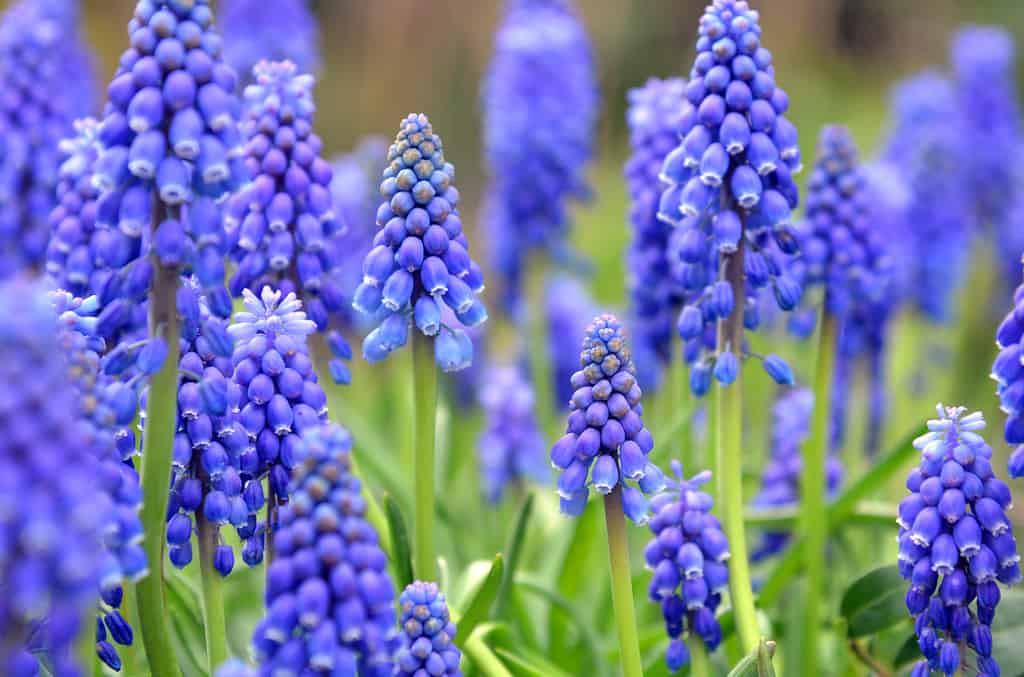
The bluish-purple grape hyacinth is relatively easy to grow. It needs full sun or partial shade and well-drained soil.
©olly kiseleva/Shutterstock.com
This lovely flower is native to central and Southern Europe and is known for its small, blue-purple flower clusters. The grape hyacinth is relatively easy to grow — all it needs is full sun or partial shade and well-drained soil. It’s also reasonably drought-tolerant, so you don’t need to worry too much about watering it once the plant is established. One of the great things about grape hyacinths is that they naturalize easily, which means they’ll come back year after year with minimal effort on your part. They make lovely groundcover in gardens and are also beautiful when planted in garden beds or borders.
4. Pasqueflower (Pulsatilla)
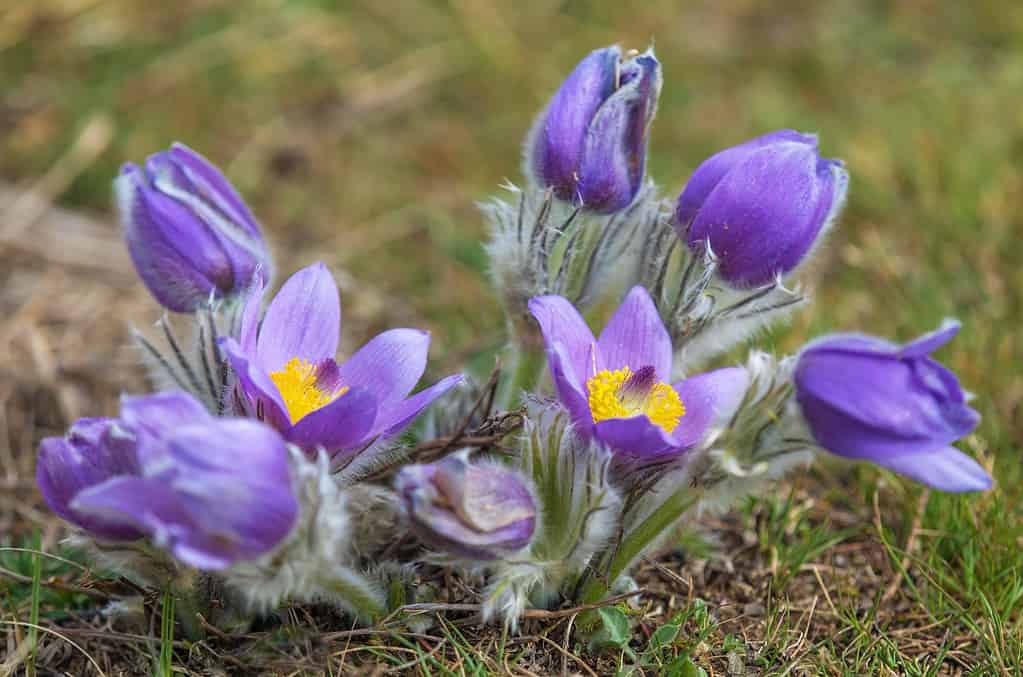
The blooms are typically an Easter-egg shade of purple.
©Daniel Prudek/Shutterstock.com
The pasqueflower is native to North America and Europe and thrives in cool, dry climates. The blooms are typically an Easter-egg shade of purple but can also be white or yellow. Pasqueflowers are relatively easy to grow and make a great addition to any garden. They prefer partial shade to full sun and well-drained soil. If you live in an area with hot summers, it’s best to plant this flower in an area with afternoon shade.
Unfortunately, this plant may also be susceptible to several different pests. Some of the most common to look out for include aphids, spider mites, and whiteflies.
5. Perennial Primrose (Primula vulgaris)
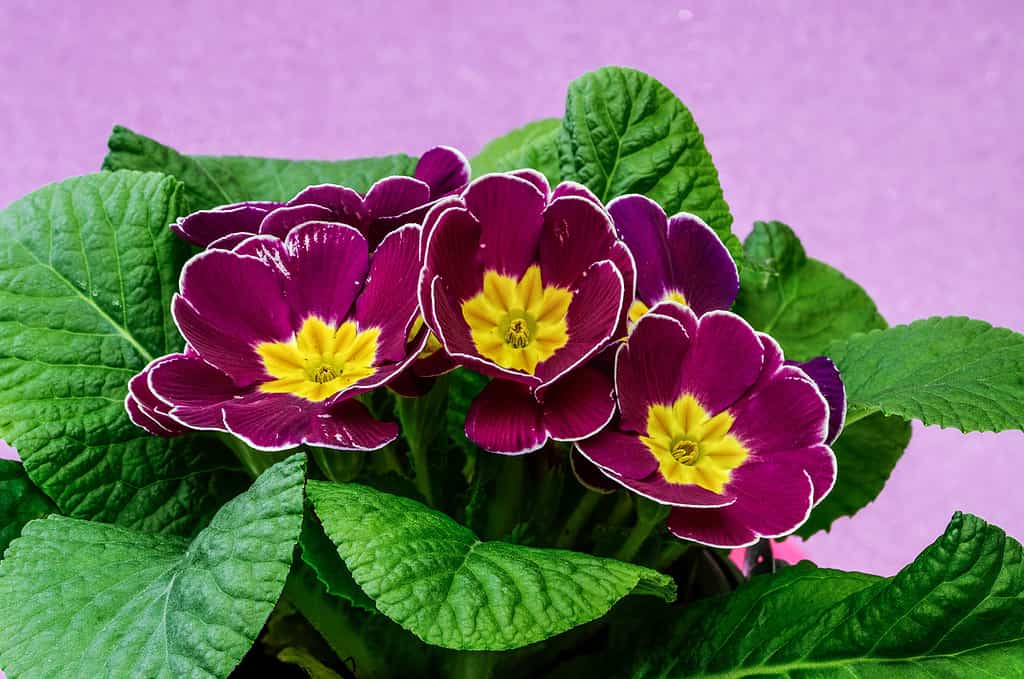
Perennial primrose blooms in the spring and needs a cool climate to thrive.
© K.Jagielski/Shutterstock.com
The perennial primrose plant is native to the Northern Hemisphere and features flowers in various colors, including dark brownish purple with yellow centers. They typically bloom in the spring and need a cool climate to thrive.
If you decide to plant perennial primrose in your garden, you should be aware of its pests, as they can cause severe damage and prevent growth. Some of the most common pests that affect the perennial primrose are slugs, aphids, and Japanese beetles. These pests can cause various problems, including eating the plant leaves, damaging the flowers, and causing overall stress to the plant. As a result, it is vital to be on the lookout for these pests and take steps to control them if they are present.
If you’re interested in growing a perennial primrose yourself, gardening enthusiasts recommend researching what soil type and environment they need to flourish. But overall, they are relatively easy to care for and make a stunning addition to any yard.
6. Lungwort (Pulmonaria)
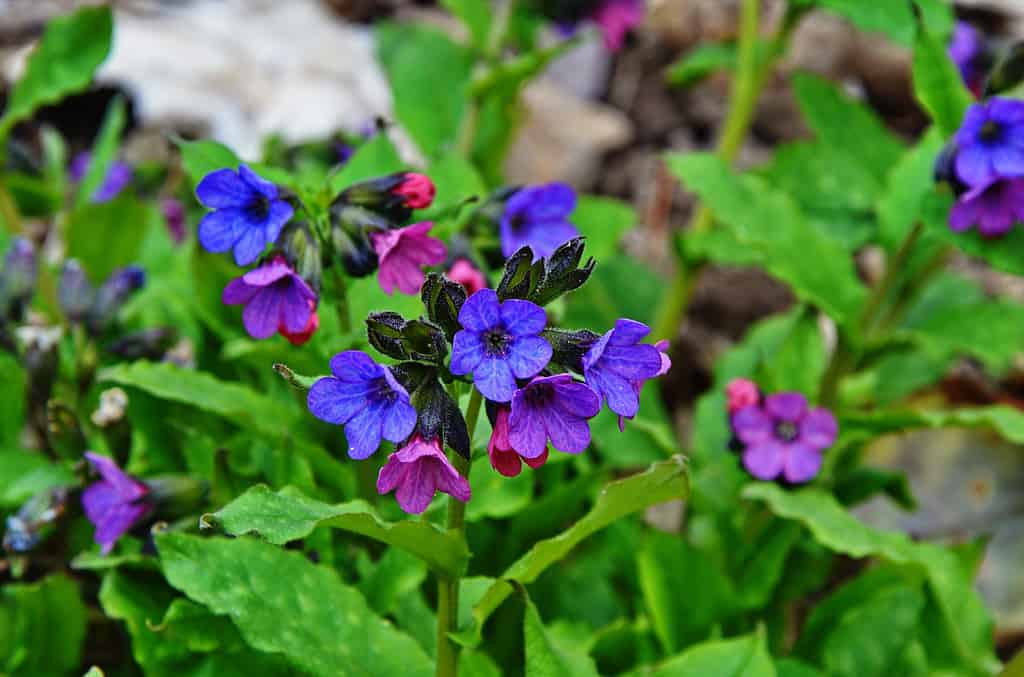
The flowers of this plant are gorgeous, ranging in color from pink to blue to deep purple.
©weha/Shutterstock.com
The lungwort is a plant that is native to North America, Europe, and Asia. The lungwort plant gets its name from its leaves being traditionally used to treat lung ailments in herbal medicine. The flowers of this plant are gorgeous, ranging in color from pink to blue to deep purple. The lungwort plant prefers cooler climates and does not usually do well in hot weather. It needs moist soil and partial shade to thrive when planted in gardens. When planting lungwort outside, make sure to give it plenty of room to grow, as it can spread quickly over time resulting in more plants.
7. Horned Violets (Viola Cornuta)

The horned violet features lavender and white petals with yellow centers. They are sure to stand out in any garden!
©Nahhana/Shutterstock.com
The flowers of the horned violet plant are lovely, featuring lavender and white petals with yellow centers. They are sure to stand out in any garden! Horned violets grow best in cooler climates, so if you’re thinking of planting them, ensure you have a spot with plenty of shade.
Like many other plants, this plant is also susceptible to a few pests, so it’s best to be aware of them. Aphids are small, wingless insects that suck the sap out of plants. This can cause the leaves of horned violets to turn yellow and eventually die. If you see any aphids on your horned violets, be sure to remove them right away. Another pest horned violets may be affected by are spider mites. Being aware of potential pests is a way to ensure your plant will be able to grow and thrive without any issues.
8. Sweet Violet (Viola Odorata)
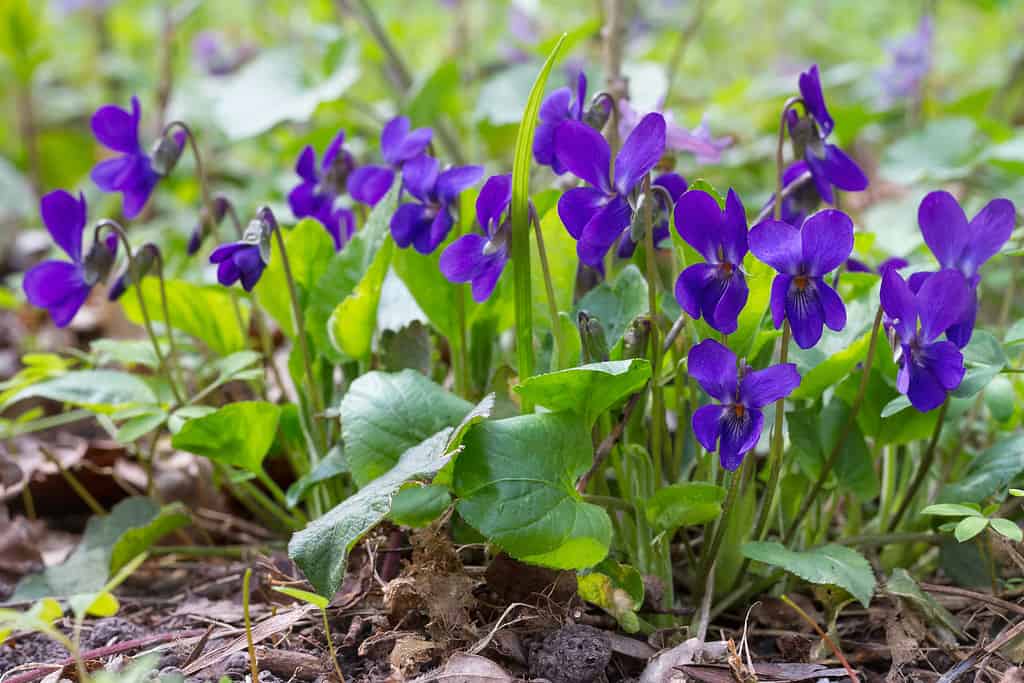
Sweet violet flowers are small and delicate and are usually royal purple or blue in color.
©rustamank/Shutterstock.com
The sweet violet flower is native to Europe, Africa, and Asia and has since been introduced to North America. Sweet violet flowers are small and delicate and are usually royal purple or blue in color. They typically bloom in the springtime. Sweet violets need a cool climate to grow properly as they may not do well in hot, humid weather, which causes the flowers to droop or wilt. They prefer partial shade and moist soil that is well-drained. They can make a wonderful addition to any garden if you live in an area with a suitable climate for them to thrive.
9. Hellebore (Helleborus orientalis)
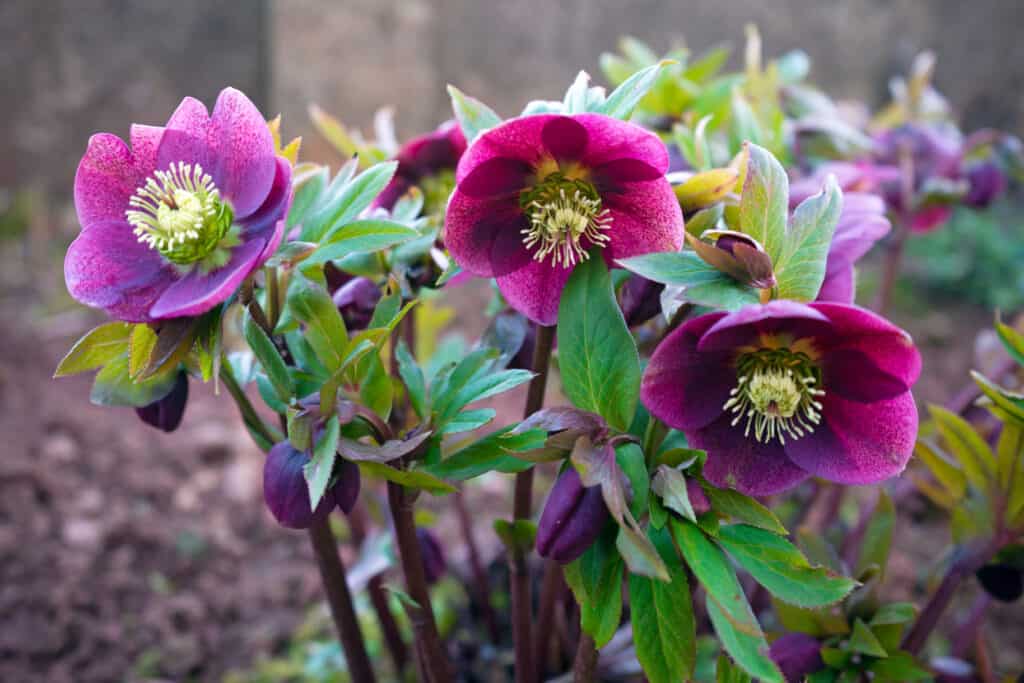
What makes hellebores unique is that they bloom in late winter or early spring, often when snowflakes are still on the ground!
©iStock.com/Maksims Grigorjevs
Hellebores are known for their stunning flowers, which come in various colors, including white, pink, purple, black, and red. They thrive in cooler climates and prefer partial shade. What makes hellebores unique is that they bloom in late winter or early spring, often when snowflakes are still on the ground! They are a sign of hope that warmer days are on the way. These flowers will add glamour and color to your garden. They are an easy-to-care-for plant, not requiring much attention once established outside.
10. Creeping Phlox (Phlox stolonifera)

The flowers can be any color from white to pink to purple and usually have a sweet fragrance.
©speakingtomato/Shutterstock.com
The creeping phlox plant is native to North America and is known for its beautiful flowers. The flowers can be any color from white to pink to purple and usually have a sweet fragrance. Creeping phlox is a great garden plant because it is easy to care for and does not require much watering. It grows best in full sun or partial shade and prefers well-drained soil.
However, keep in mind that this plant can be invasive, so it is essential to keep an eye on it and ensure it does not spread too much. Another thing to note is that this plant can attract some pests, such as aphids, scale insects, and thrips. But insecticidal soap or other organic methods can usually control these pests without too much hassle.
11. Pansy (Viola tricolor var. hortensis)
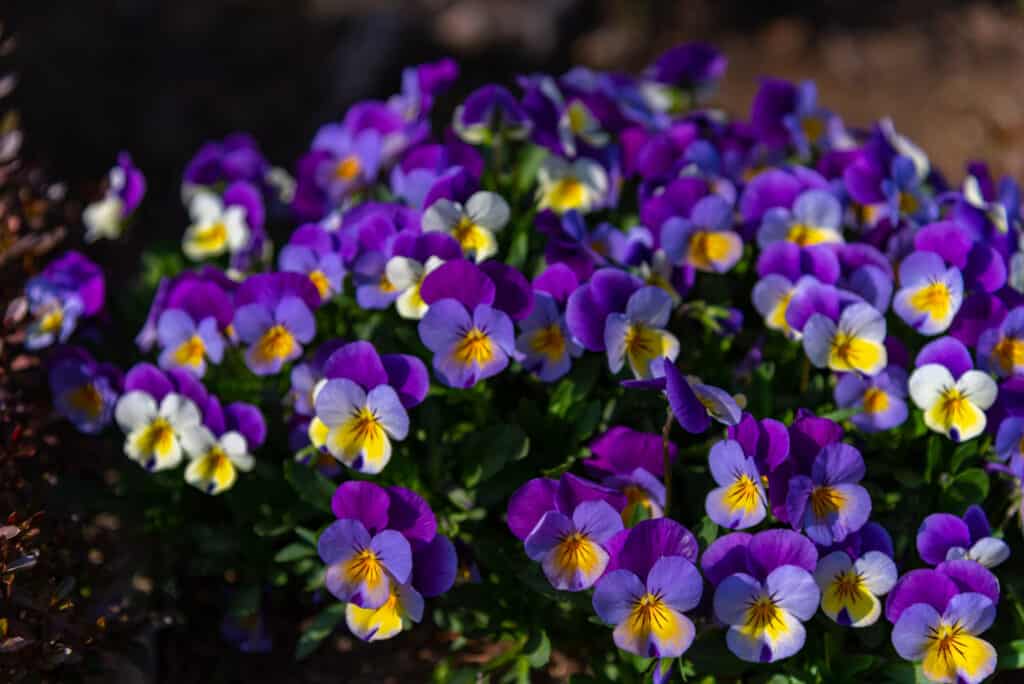
Pansies typically grow best in cooler climates with partial sun exposure, and need well-drained soil to thrive.
©Shawn.ccf/Shutterstock.com
Pansies are very popular garden flowers available in various colors, including yellow, purple, pink, blue, black, and white. Purple varieties often feature several shades of purple and bright yellow centers. They typically grow best in cooler climates, with partial sun exposure, and need well-drained soil to thrive.
Unfortunately, they are another plant that can be susceptible to typical pests like aphids and spider mites, so it’s essential to watch for those if you’re growing these delicate flowers in your garden. But, overall, when well looked after, they make a lovely, colorful addition to any garden or yard.
12. Annual Primrose (Primula Acaulis)
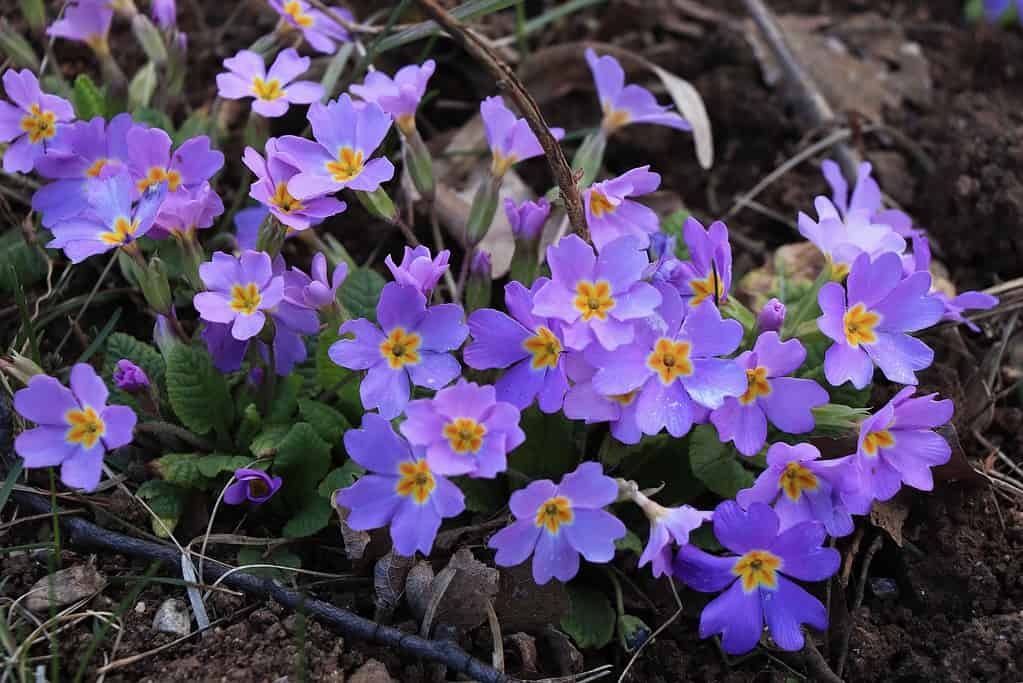
The purple types are often pastel in color, with star shaped yellow-orange centers.
©Antoniya Kadiyska/Shutterstock.com
The annual primrose flower comes in various shades of color, including pink, purple, yellow, and white. The purple types are often pastel in color, with star shaped yellow-orange centers. They are native to South America and Asia and usually thrive in cool, moist climates. One thing to remember if you’re growing an annual primrose is that they can be susceptible to fungal diseases if the leaves stay too wet for too long. So, make sure to water them at the base of the plant and not directly on the leaves. Also, be sure to deadhead any spent blooms to encourage new flowering growth.
13. Purple Passionflower (Passiflora incarnata)
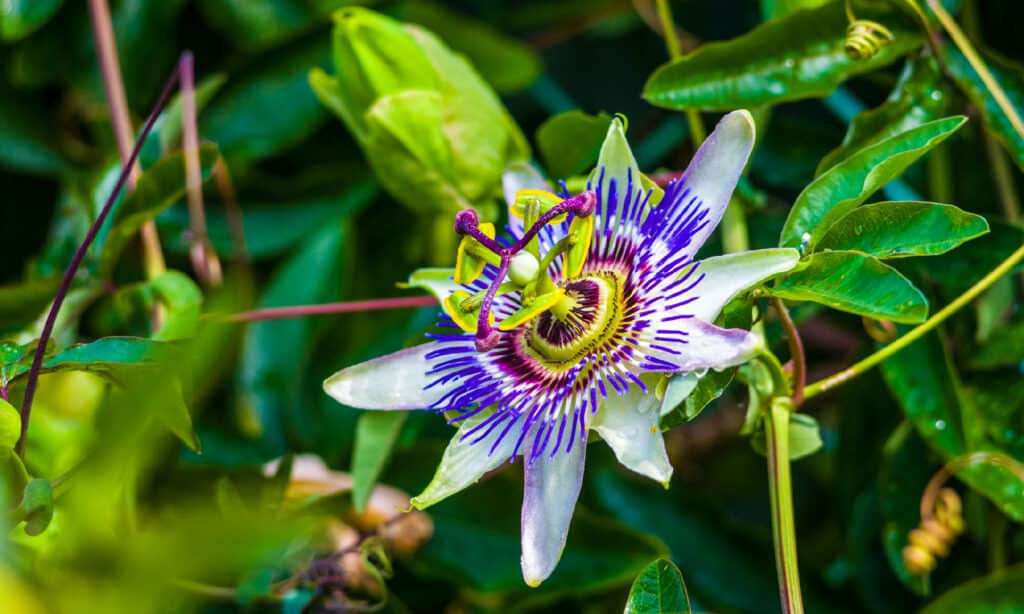
Purple passionflowers are known to attract bees and butterflies!
©iStock.com/Shedu
This plant is native to the Southeastern United States but can grow in many climates. The flowers are usually a deep purple but can also be found in white and pink. Purple passionflowers are known to attract bees and butterflies, so if you want to add pollinators to your garden, this is a great plant to consider!
Passionflowers are also relatively pest-resistant but may be susceptible to aphids and scale insects. If you notice any pests on your plants, treat them immediately to avoid any further damage to the plant.
14. Chaste Tree (Vitex agnus-castus)

The chaste tree grows best in warmer climates with full sun exposure but can tolerate some cooler temperatures.
©Wut_Moppie/Shutterstock.com
The chaste tree is native to the Mediterranean region and is known for its lovely flowers. The flowers can be of various colors, from white to pink to purple, and usually have a unique shape. The chaste tree grows best in warmer climates with full sun exposure but can tolerate some cooler temperatures.
One thing to watch out for with this plant is that it can also attract plant pests like aphids and scale insects. But don’t worry — there are some easy ways to prevent this from happening. Just monitor your plants and check them regularly for any signs of pests.
15. Lilac (Syringa)

Lilacs have a distinct smell that many people enjoy and are known for being relatively easy to grow.
©NikolayTsyu/Shutterstock.com
Lilacs are popular flowers available in many different colors, including white, purple, pink, and lavender. They have a distinct smell that many people enjoy and are known for being relatively easy to grow. Lilacs need full sun and well-drained soil to thrive. They are drought-tolerant once established, but they will produce more flowers if given regular watering during dry periods. It is also essential to fertilize lilacs regularly to promote healthy growth.
Summary of 15 Amazing Purple Spring Flowers
Here’s a recap of the 15 pretty purple flowering plants that we took a look at:
| Number | Common Name | Scientific Name | Flowers |
|---|---|---|---|
| 1 | Crocus | Crocus sativus | Bright purple, white, and yellow shades |
| 2 | Dwarf Iris George | Iris histroides ‘George’ | Jewel-toned purple flowers |
| 3 | Grape Hyacinth | Muscari | Small, blue-purple flower clusters |
| 4 | Pasqueflower | Pulsatilla | Easter-egg shade of purple but can also be white or yellow |
| 5 | Perennial Primrose | Primula vulgaris | Various colors, including dark brownish purple with yellow centers |
| 6 | Lungwort | Pulmonaria | Range in color from pink to blue to deep purple |
| 7 | Horned Violets | Viola Cornuta | Lavender and white petals with yellow centers |
| 8 | Sweet Violet | Viola Odorata | Small and delicate, usually royal purple or blue |
| 9 | Hellebore | Helleborus orientalis | Various colors, including white, pink, purple, black, and red |
| 10 | Creeping Phlox | Phlox stolonifera | White, pink, or purple |
| 11 | Pansy | Viola tricolor var. hortensi | Various colors, including yellow, purple, pink, blue, black, and white; purple varieties often feature several shades of purple and bright yellow centers |
| 12 | Annual Primrose | Primula Acaulis | Various shades, including pink, purple, yellow, and white; purple varieties can be pastel in color, with star shaped yellow-orange centers |
| 13 | Purple Passionflower | Passiflora incarnata | Usually a deep purple but can also be found in white and pink |
| 14 | Chaste Tree | Vitex agnus-castus | Various colors, including white, pink, and purple |
| 15 | Lilac | Syringa | Different colors, including white, purple, pink, and lavender |
The photo featured at the top of this post is © iStock.com/jamesvancouver
Thank you for reading! Have some feedback for us? Contact the AZ Animals editorial team.






